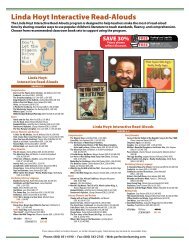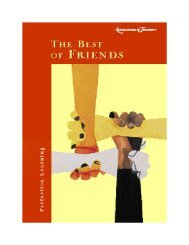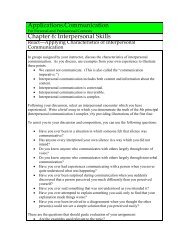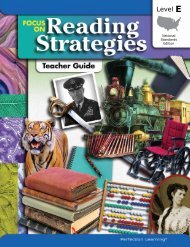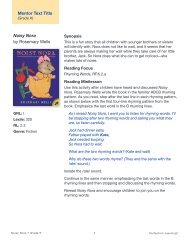Creative Communication - Perfection Learning
Creative Communication - Perfection Learning
Creative Communication - Perfection Learning
Create successful ePaper yourself
Turn your PDF publications into a flip-book with our unique Google optimized e-Paper software.
193<br />
Chapter 37: Tickle The Funny Bone<br />
While most speeches to entertain appeal to the audience’s sense of humor,<br />
entertainment can also be provided by novel or unique information, anecdotes on unusual<br />
people, or an exciting dramatic description of events. The basic requirement is that the<br />
speaker holds audience attention in a pleasant way.<br />
False is the idea that entertainment speeches must make the listeners roll down the<br />
aisles with hearty laughter. Effective speeches can produce numerous responses—from<br />
an inner smile to a loud guffaw.<br />
Also false is the idea that speeches to entertain consist only of a series of jokes. While<br />
jokes may be used, the entertainment speech should progress from an underlying serious<br />
theme, always there but never dominating. Unique stories, verses, and anecdotes weave<br />
in and around the central theme—frolicking, sometimes peeking around corners, but<br />
constantly catching the audience’s attention and maintaining their interest in an<br />
enjoyable though not necessarily humorous manner.<br />
Humor, of course, is the favorite vehicle. When you use it, be sure it (1) relates to your<br />
subject and (2) is in good taste. Never offend any member of the audience by telling offcolor<br />
jokes. The supply of funny and clean stories is extensive. If you can’t find them, it<br />
means you haven’t bothered to look. Keep in mind, too, that it is not necessary to use<br />
“canned” material from books or magazines. Original humor—funny things that have<br />
happened to you or your friends, or humor you make up—is usually the most entertaining<br />
of all material. Remember, the magic lies in treatment, not in subject matter. Almost<br />
anything can be presented entertainingly if you approach it with a different viewpoint<br />
and spice it with human interest.<br />
When you want to evoke laughter, try the following methods:<br />
(1) Exaggeration or overstatement: Tall tales and “Texas” jokes fit in this category.<br />
Example: A group of golfers were telling tall stories. “Once,” said a golfer,<br />
“I drove a ball, accidentally of course, through a cottage<br />
window. The ball knocked over a candle and the place caught<br />
on fire.”<br />
“What did you do?” asked his friends.<br />
“Oh,” said the golfer, “I immediately teed another ball, took<br />
careful aim, and hit the fire alarm on Main Street. That<br />
brought out the fire trucks before any damage was done.”<br />
(2) Surprise turns: Start out by saying the normal thing and end up by saying<br />
something unexpected.<br />
Example: If at first you don’t succeed, you are about average.<br />
Example: Roses are red, Violets are blue, Orchids are $16.95, Will<br />
dandelions do?<br />
<strong>Creative</strong> <strong>Communication</strong>—Hardcover Student Edition sampler




